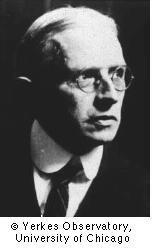Henry Norris Russell
Astronomer and astrophysicist; b. 25 October 1877 (Oyster Bay, New York, USA), d. 18 February 1957 (Princeton, New Jersey).
 Henry Russell was the son of a Presbyterian minister. He entered Princeton Preparatory School in 1890 and Princeton University in 1893 and graduated in 1897. In 1900 he obtained his PhD from Princeton with an analysis of the way in which Mars perturbs the orbit of the asteroid Eros.
Henry Russell was the son of a Presbyterian minister. He entered Princeton Preparatory School in 1890 and Princeton University in 1893 and graduated in 1897. In 1900 he obtained his PhD from Princeton with an analysis of the way in which Mars perturbs the orbit of the asteroid Eros.
Russell spent the following years at the Cambridge University Observatory in England with work on the determination of star distances through photographic parallax measurements. In 1905 he returned to Princeton to take a position as instructor.
Russell's parallax work had convinced him that astronomy should turn from data gathering programs to problem oriented research guided by hypothesis and verification. He was appointed professor in 1911 and became director of the observatory in 1912.
One of Russell's major research interests was the analysis of the orbits of binary stars and the calculation of the masses and dimensions of binary stars that appear to move in front of each other as they orbit about their common centre of gravity and thus show characteristic variations in brightness. He noticed that blue stars are intrinsically brighter than yellow stars and yellows are brighter than reds and discovered the relationship between a star's true brightness and its spectrum.
Russell published his findings in 1914 in a diagram now known as the Hertzsprung-Russell diagram. (Ejnar Hertzsprung had discovered the same relationship three years earlier.) Based on his observations he developed a theory of stellar evolution based exclusively on gravitational contraction, which remained the accepted theory until the mid-1920s, when nuclear processes were recognized as contributing to stellar evolution
When it was recognized that that the physical state of a star could be quantitatively analyzed through its spectrum Russell concentrated on spectrum analysis. He became a senior Carnegie research associate with annual residence at Mount Wilson Observatory near Pasadena, California, which gave him access to the best laboratory and astronomical spectroscopic data in the world.
Russell wrote a textbook on astronomy with two Princeton colleagues and actively promoted astronomy to the general public. For 43 years, starting in 1900, he wrote for the lay publication Scientific American, first in a simple column that accompanied a night sky map, later expanding his contributions to a forum on the status and progress of astronomy. He remained an active Christian through his life; in his regular lectures on the "Scientific approach to Christianity" he argued that science could strengthen religion by revealing the unity of design in nature.
Reference
DeVorkin, D. H. (2002) Henri Norris Russell. Encyclopaedia Britannica 2002 ed.
home
 Henry Russell was the son of a Presbyterian minister. He entered Princeton Preparatory School in 1890 and Princeton University in 1893 and graduated in 1897. In 1900 he obtained his PhD from Princeton with an analysis of the way in which Mars perturbs the orbit of the asteroid Eros.
Henry Russell was the son of a Presbyterian minister. He entered Princeton Preparatory School in 1890 and Princeton University in 1893 and graduated in 1897. In 1900 he obtained his PhD from Princeton with an analysis of the way in which Mars perturbs the orbit of the asteroid Eros.